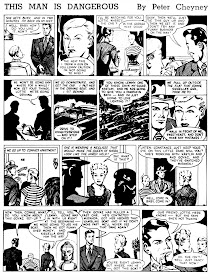 |
| [1] Belinda, June 23, 1938. |
by John Adcock
T HERE is very little information to be found on British newspaper comic strip history — we wrote last year, see links below. Here is our latest. Any additional information is still welcomed, especially missing names of WRITERS and ARTISTS…
 |
| [2] Ruggles, by Frank and Steve Dowling, June 23, 1938. |
 |
| [3] Ruggles, by Frank and Steve Dowling, June 25, 1938. |
★ Ruggles — at times titled The Ruggles or The Ruggles Family — by Frank Dowling (writer; from 1946 succeeded by Guy Morgan, William Connor & Ian Gammidge) & “Blik” (artist; real name Steve Dowling, sometimes ghosted by Angus Scott): debuted 11/MAR/1935; ended 03/AUG/1957.
 |
| [4] Introducing Belinda, by William Connor and “Gloria” [from Australian newspaper], Dec 16, 17, 18, 19, 1949. |
★ Belinda Blue-Eyes by William Connor (writer) & “Gloria” (artist; later drawn by Steve Dowling under the same pseudonym; sometimes ghosted by Angus Scott): debuted 30/SEP/1935; title shortened to Belinda 07/SEP/1939; drawn by Tony Royle from 1943; written by Peter O’Donnell for a while in 1952; later scripts by Don Freeman; ended 17/OCT/1959.
 |
| [5] Gordon Fife, by Bob Moore and Carl Pfeufer, [from Australian newspaper] July 24, 1937. |
 |
| [6] Gordon Fife, by Bob Moore and Carl Pfeufer, [from Australian newspaper] July 31, 1937. |
★ Gordon Fife, Soldier of Fortune (USA) by Bob Moore (writer) & John Hales (art), later drawn by Carl Pfeufer: debuted 03/AUG/1936; ended 16/OCT/1937.
CONTINUED IN OUR NEXT:
Terror Keep and Buck Ryan…
GO BACK TO PART 1 HERE.




















































